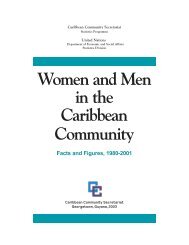CARICOM CAPACITY DEVELOPMENT PROGRAMME (CCDP)
CARICOM CAPACITY DEVELOPMENT PROGRAMME (CCDP)
CARICOM CAPACITY DEVELOPMENT PROGRAMME (CCDP)
Create successful ePaper yourself
Turn your PDF publications into a flip-book with our unique Google optimized e-Paper software.
National Census Report 2001, St. Vincent and the Grenadinesby age group were higher compared to female in all the age groups except in the 15 to 19 agegroup, and the gap in the unemployment rates for males and females was much higher among the35 to 64 years population compared to those in the younger age groups and the elderly.The population of the youngest age group experienced the highest unemployment rate. Those inthe 15 to 19 age group had an unemployment rate of 51.47 per cent, and the rate was evenhigher among the females (54.17 per cent) compared to males (50.19 per cent) in this age group.These figures reveal that there were more people in this age group that wanted work and lookedfor work compared to those who had a job. This is the only age group that had more unemployedthan employed persons in the labour force and higher female compared to male unemploymentrate.5.6 Population Not in the Labour ForceIn 2001, the population that was not in the labour force (29 436) was higher compared to 1991(25 191) and the number of females (20 039) was more than two times higher than the males(9 397). During the 1991/2001 intercensal period, females not in the labour force increased by1 284 or 6.47 per cent, while the males increased by 3 027 or 47.52 per cent. One of the factorsthat might have contributed to the exceptional increase among males not in the labour force is theincrease in the number of them that attended school full time, which placed them out of thelabour force.The population not in the labour force was mainly engaged in home duties (52.46 per cent),attended school (20.38 per cent) or retired (18.54 per cent). Only 6.28 per cent reported that theywere disabled or unable to work. Apporximately, three out of every five females not in the labourforce were engaged in home duties (63.07 per cent), while 16.83 per cent attended school. Maleswere mainly engaged in these same two activities however, at lower proportions, 37 per cent inhome duties and 38.67 per cent attended school. More than one quarter of the males (8.82 percent) were retired compared to 14.27 per cent of females.72










